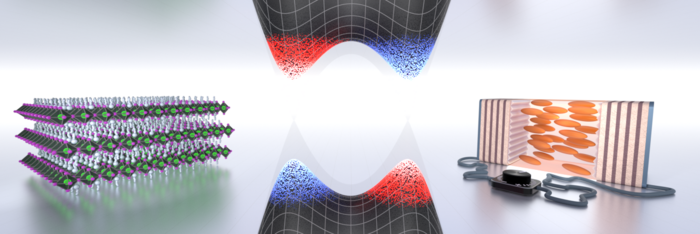Scientists from the Faculty of Physics at the University of Warsaw in cooperation with the Military University of Technology, the Italian CNR Nanotec, the British University of Southampton and the University of Iceland obtained a new photonic system with electrically tuned topological features, constructed of perovskites and liquid crystals. You can read about the discovery, that can be used in the creation of efficient and unconventional light sources, in the latest “Science Advances”.

Credit: Mateusz Krol, source: Faculty of Physics, University of Warsaw
Scientists from the Faculty of Physics at the University of Warsaw in cooperation with the Military University of Technology, the Italian CNR Nanotec, the British University of Southampton and the University of Iceland obtained a new photonic system with electrically tuned topological features, constructed of perovskites and liquid crystals. You can read about the discovery, that can be used in the creation of efficient and unconventional light sources, in the latest “Science Advances”.
Perovskites are materials that have a chance to revolutionize energy. These are durable and easy-to-produce materials, the special property of which is a high solar light absorption coefficient and therefore are used to build new, more efficient photovoltaic cells. In recent years, the emission properties of these materials, so far underestimated, have been used.
– We noticed that two-dimensional perovskites are very stable at room temperature, have high exciton binding energy and high quantum efficiency – describes PhD student Karolina Lempicka-Mirek from the Faculty of Physics at the University of Warsaw, the first author of the publication – These special properties can be used in the construction of efficient and unconventional light sources. This is important for applications in new photonic systems. – In particular, it is planned to use perovskites for information processing with high energy efficiency – adds Barbara Pietka, researcher from University of Warsaw.
Scientists managed to create a system in which excitons in a two-dimensional perovskite were strongly coupled with photons trapped in a birefringent photonic structure: a two-dimensional optical cavity filled with a liquid crystal. – In such a regime, new quasiparticles are created: excitonic polaritons, which are known primarily for the possibility of phase transition to non-equilibrium Bose-Einstein condensate, the formation of superfluid states at room temperature and strong light emission similar to laser light – explains Barbara Pietka.
– Our system turned out to be an ideal platform for creating photonic energy bands with non-zero Berry curvature and studying optical spin-orbit effects mimicking those previously observed in semiconductor physics at cryogenic temperatures – explains Mateusz Krol PhD student from the Faculty of Physics at the University of Warsaw. – In this case, we recreated the Rashba-Dresselhaus spin-orbit coupling in the strong light-matter coupling regime at room temperature.
– The generation of a polariton band with a non-zero Berry curvature was possible thanks to designing a special twist of the liquid crystal molecules at the surface of the mirrors – explains the co-author of the study, Wiktor Piecek from the Military University of Technology, where the tested optical cavities were fabricated.
– Berry curvature describes quantitatively the topological properties of energy bands in materials such as 3D topological insulators, Weil semi-metals and Dirac materials – explains Helgi Sigurdsson from the University of Iceland. – It plays primarily a key role in anomalous transport and the quantum Hall effect. In recent years, many ground-breaking experiments have been carried out in the design and study of geometric and topological energy bands in ultracold atomic gasses and photonics.
– The photonic structure developed in this work, using the spin-orbit coupling and the properties of polaritons, opens the way to study the topological states of light fluids at room temperature – explains Jacek Szczytko from the Faculty of Physics at the University of Warsaw. – Moreover, it can be used in optical neuromorphic networks, where precise control over nonlinear properties of photons is necessary – adds Barbara Pietka.
An international team of scientists conducted research supported, among others, by the National Science Center (grants 2017/27/B/ST3/00271, 2018/31/N/ST3/03046), NAWA Canaletto grant PPN/BIT/2021/1/00124/U/00001, European Union FET-Open program Horizon 2020, grant “TopoLight” (964770).
Physics and astronomy at the University of Warsaw appeared in 1816 as part of the then Faculty of Philosophy. In 1825, the Astronomical Observatory was established. Currently, the Faculty of Physics at the University of Warsaw consists of the following institutes: Experimental Physics, Theoretical Physics, Geophysics, the Department of Mathematical Methods and the Astronomical Observatory. The research covers almost all areas of modern physics, on scales from quantum to cosmological. The Faculty’s research and teaching staff consist of over 200 academic teachers, 81 of whom are professors. About 1,000 students and over 170 doctoral students study at the Faculty of Physics at the University of Warsaw.
SCIENTIFIC PUBLICATION:
K. Lempicka-Mirek, M. Krol, H. Sigurdsson, A. Wincukiewicz, P. Morawiak, R. Mazur, M. Muszynski, W. Piecek, P. Kula, T. Stefaniuk, M. Kaminska, L. De Marco, P. G. Lagoudakis, D. Ballarini, D. Sanvitto, J. Szczytko, B. Pietka Electrically tunable Berry curvature and strong light-matter coupling in liquid crystal microcavities with 2D perovskite
Science Advances 8, 7533 (2022)
https://www.science.org/doi/10.1126/sciadv.abq7533
CONTACT:
Barbara Pietka
Faculty of Physics University of Warsaw
email: [email protected]
Phone number +48 55 32 764
RELATED WEBSITES WWW:
http://polariton.fuw.edu.pl/
Website of the Polariton Group
https://www.fuw.edu.pl/faculty-of-physics-home.html
Website of the Faculty of Physics at the University of Warsaw
https://www.fuw.edu.pl/press-releases.html
Press service of the Faculty of Physics at the University of Warsaw
GRAPHIC MATERIALS:
FUW221013b_fot01
https://www.fuw.edu.pl/tl_files/press/images/2022/FUW221013b_fot01.png
“Electrically tuned Berry curvature and strong light-matter coupling in the liquid crystal cavity with perovskite at room temperature” (visualisation: Mateusz Krol, source: Faculty of Physics, University of Warsaw).
Journal
Science Advances
DOI
10.1126/sciadv.abq7533
Article Title
Electrically tunable Berry curvature and strong light-matter coupling in liquid crystal microcavities with 2D perovskite
Article Publication Date
5-Oct-2022




